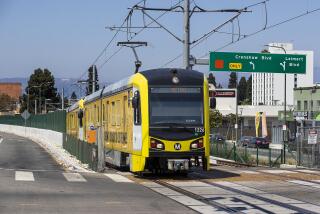101 Ways to Ease Congestion Narrowed to a Few
Transportation officials on Tuesday announced their top options to alleviate congestion on the 101 Freeway: widening the roadway, double-decking to create carpool lanes and erecting an elevated rail line.
Narrowed down from an earlier list of 12, one of the proposals--or some combination of the three--will become the final strategy. That decision could be made as early as December.
“We have a good set of options going forward,” said Laurie Newman, senior deputy for state Sen. Sheila Kuehl (D-Santa Monica) and chairwoman of the committee studying 40 miles of the freeway from Thousand Oaks to downtown Los Angeles.
Consisting of parts of the Ventura and Hollywood freeways, that section of the 101 is one of the most congested corridors in California. In the next few months, the 101 study committee--which also includes representatives from the California Department of Transportation, the Metropolitan Transportation Authority, the Las Virgenes-Malibu Council of Governments and the city and county of Los Angeles--will seek more public feedback before reaching a decision.
The solutions now under consideration are:
* Widening the four-lane sections so that the entire corridor has five lanes, plus an additional high-occupancy vehicle lane in each direction. Estimated cost: $3 billion.
* All of the above, plus installing a rail line down the middle. The carpool lane and rail line could be elevated in some freeway segments. Estimated cost: $5.7 billion to $11.8 billion, depending on how much double-decking is required.
* Building a second tier for carpoolers and buses only. Estimated cost: $7.3 billion.
All the options call for some widening of the corridor as well as making improvements to nearby streets and to public transit.
Officials declined to estimate how many homes and businesses would be affected by the three plans or how long each option would take to complete. They did say, if all goes well, groundbreaking could begin within the decade.
Before announcing the final three options, officials considered such criteria as environmental impact, effectiveness in reducing congestion, public opinion and cost.
Plans to expand the 101 outward--and possibly skyward--are causing an uproar among some who live near the corridor.
“If an earthquake comes ... having a double-deck could destroy the whole freeway,” said Richard Close, president of the Sherman Oaks Homeowners Assn. The group also opposes any widening that could bring more traffic, noise and environmental problems into their neighborhoods.
Gerald A. Silver, president of the Coalition of Freeway Residents, said his group also strongly opposes any expansion. “It would [destroy] hundreds of residences and businesses and thousands would have to be relocated,” he said.
But transportation officials said they have received feedback from more than 1,000 people in the last few months, many supporting some expansion.
By 2025, population along the corridor will grow by 25%, according to projections by the Southern California Assn. of Governments, and traffic is expected to grow accordingly.
Currently, it takes about 80 minutes to drive from Thousand Oaks to downtown Los Angeles during rush hour, said Tom Jenkins, vice president of Parsons Brinckerhoff Quade & Douglas Inc., a consulting firm hired to perform the study. If nothing is done, by 2025, it would take 99 minutes to make the trip, according to projections.
The proposed strategies would reduce travel times by as much as 41 minutes for single drivers, 50 minutes for carpoolers and 44 minutes for those using public transportation, Jenkins said.
Public meetings on the options for the 101 will be held in Calabasas, Encino and Hollywood in September. For information online, visit www.communityspeakup.com /101/.
More to Read
Sign up for Essential California
The most important California stories and recommendations in your inbox every morning.
You may occasionally receive promotional content from the Los Angeles Times.










